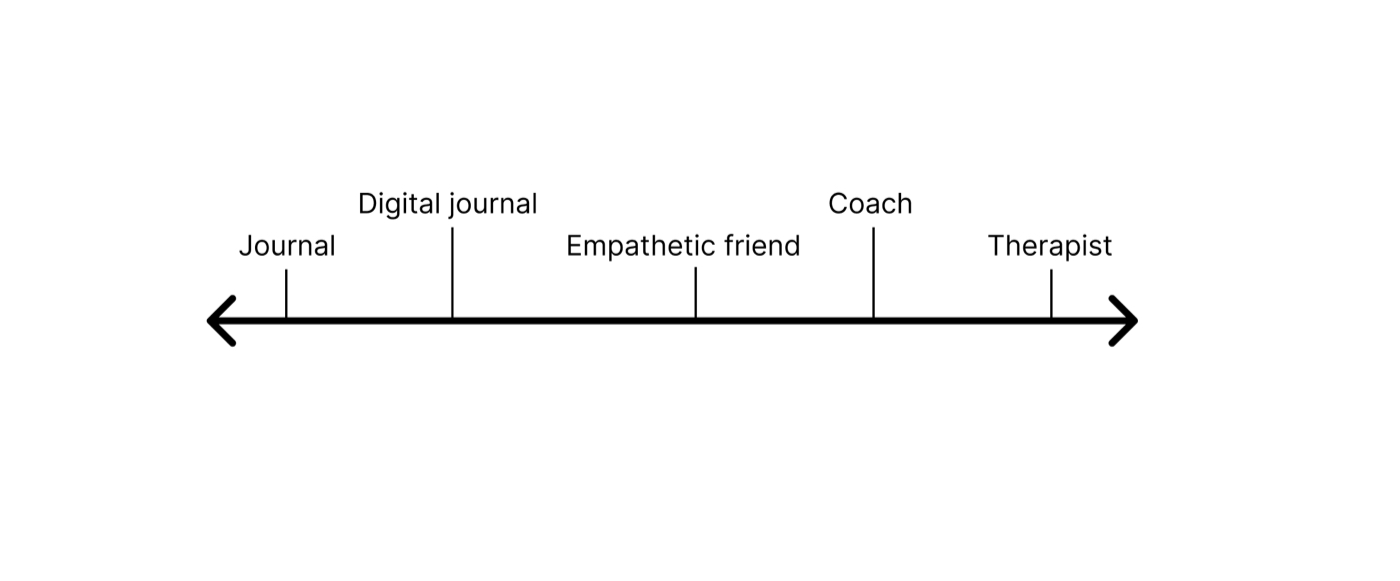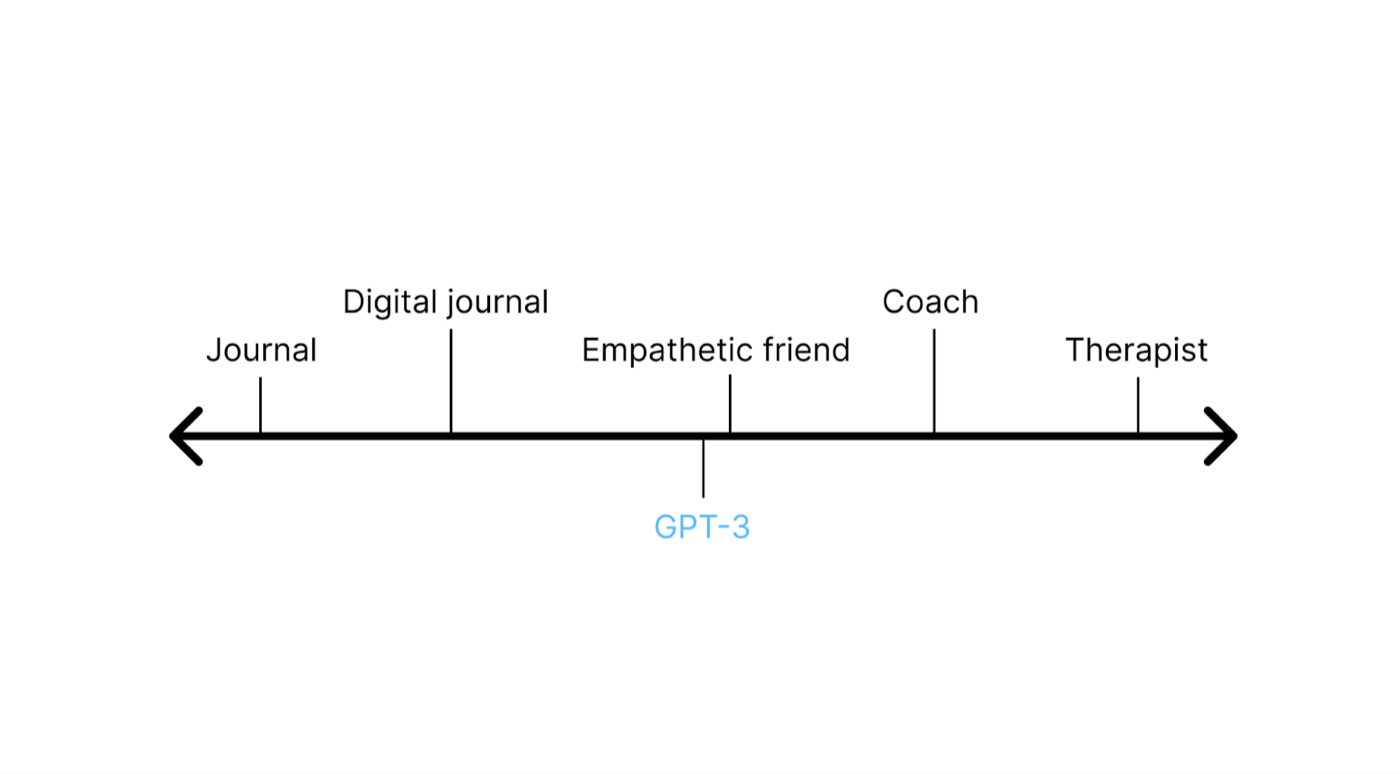
Sponsor Every
Do you run a software company looking to reach an audience of early-adopters? Consider sponsoring our smart long-form essays on tech, AI, and productivity:
For the past few weeks, I’ve been using GPT-3 to help me with personal development. I wanted to see if it could help me understand issues in my life better, pull out patterns in my thinking, help me bring more gratitude into my life, and clarify my values.
I’ve been journaling for 10 years, and I can attest that using AI is journaling on steroids.
To understand what it’s like, think of a continuum plotting levels of support you might get from different interactions:
Talking to GPT-3 has a lot of the same benefits of journaling: it creates a written record, it never gets tired of listening to you talk, and it’s available day or night.
If you know how to use it correctly and you want to use it for this purpose, GPT-3 is pretty close, in a lot of ways, to being at the level of an empathic friend:
If you know how to use it right, you can even push it toward some of the support you’d get from a coach or therapist. It’s not a replacement for those things, but given its rate of improvement, I could see it being a highly effective adjunct to them over the next few years.
People who have been using language models for much longer than I have seem to agree:
(Nick is a researcher at OpenAI. He’s also into meditation and is generally a great follow on Twitter.)
It sounds wild and weird, but I think language models can have a productive, supportive role in any personal development practice. Here’s why I think it works.
Why chatbots are great for journaling
Journaling is already an effective personal development practice.
It can help you get your thoughts out of your head, rendering them less scary. It shows you patterns in your thinking, which increases your self-awareness and makes it easier for you to change.
It creates a record of your journey through life, which can tell you who you are at crucial moments. It can help you create a new narrative or storyline for life events so that you can make meaning out of them.
It can also guide your focus toward emotional states like gratitude, or directions you want your life to go in, rather than letting you get swept up in whatever is currently going on in your life.
But journaling has a few problems. For one, it’s sometimes hard to sit down and do it. It can be difficult to stare at a blank page and know what to write. For another, sometimes it feels a little silly—is summarizing my day really worth something?
Once you get over those hurdles, as a practice it tends to get stale. You don’t read through your old entries that often, so the act of writing down your thoughts and experiences doesn’t compound in the way that it should. The prompts you use often get old: one like, “What are you grateful for today?” might work for the first few weeks, but after a while you need something fresh in order for the question to feel genuine.
You want your journal to feel like an intimate friend that you can confide in—someone who’s seen you in different situations and can reflect back to you what’s important in crucial moments. You want your journal to be personal to you, and the act of journaling to feel fresh and full of hope and possibility every time you do.
Unfortunately, paper isn’t great at those things. But GPT-3 is.
Journaling in GPT-3 feels more like a conversation, so you don’t have to stare at a blank page or feel silly because you don’t know what to say. The way it reacts to you depends on what you say to it, so it’s much less likely to get stale or old. (Sometimes it does repeat itself, which is annoying but I think long-term solvable.) It can summarize things you’ve said to it in new language that helps you look at yourself in a different light and reframe situations more effectively.
In this way, GPT-3 is a mashup of journaling and more involved forms of support like talking to a friend. It becomes a guide through your mind—one that shows unconditional positive regard and acceptance for whatever you’re feeling. It asks thoughtful questions, and doesn’t judge. It’s around 24/7, it never gets tired or sick, and it’s not very expensive.
Let me tell you about how I use it, what its limitations are, and where I think it might be going.
How I started with GPT-3 journaling
I didn’t think of using GPT-3 in this way myself. I saw Nick Cammarata’s tweets about it over the years first. My initial reaction was a lot of skepticism mixed with some curiosity.
After we launched Lex and I got more interested in AI, I remembered those tweets and decided to play around for myself.
I started in the OpenAI playground—a text box where you input a prompt that tells GPT-3 how you want it to behave, and then interact with it:
The Only Subscription
You Need to
Stay at the
Edge of AI
The essential toolkit for those shaping the future
"This might be the best value you
can get from an AI subscription."
- Jay S.
Join 100,000+ leaders, builders, and innovators

Email address
Already have an account? Sign in
What is included in a subscription?
Daily insights from AI pioneers + early access to powerful AI tools













Comments
Don't have an account? Sign up!
What do you use to save the information? Cut and paste intro another program for text?
Loved this, are any of your projects available to try?
@nattaliehartwig not yet, coming soon!
@danshipper Hi Dan, Yet?
Is your persona bot available to paying members yet?
How wonderful! Have you released the code you used to create the bot?
What an amazing story! Makes me start journaling today!
Great idea.
Dan - great use case! I love what you've documented and built. Can you share it? Would love to use it. I need it in my life! lol
Really interested in this and building a product based on the concept. I thought waiting for the chat gtp api release would be the way forward vs GPT3 - precisely because of the lack of continuation that is assumed or needed in a personal reflection/wisdom app. Eager to see what you have built (aka Lenny’s bot, and this journaling app)
Is the bot available yet?
Love your stuff brother hard to put you down keep going going going
Clinical psychologist here, and a wonderful fascinating read. Great work Dan 👏
Great article! PLEASE let us know when your bot is available! Looking for it!
This is a fascinating read. Have you further dwelled deeper into this with the newer models and APIs?
Hey Dan. I'm curious about the bot's status. Have you thought about publishing it as a GPT?
this was great and I have a friend who has done something similar and his experience and this post has me interested in testing this out for myself.